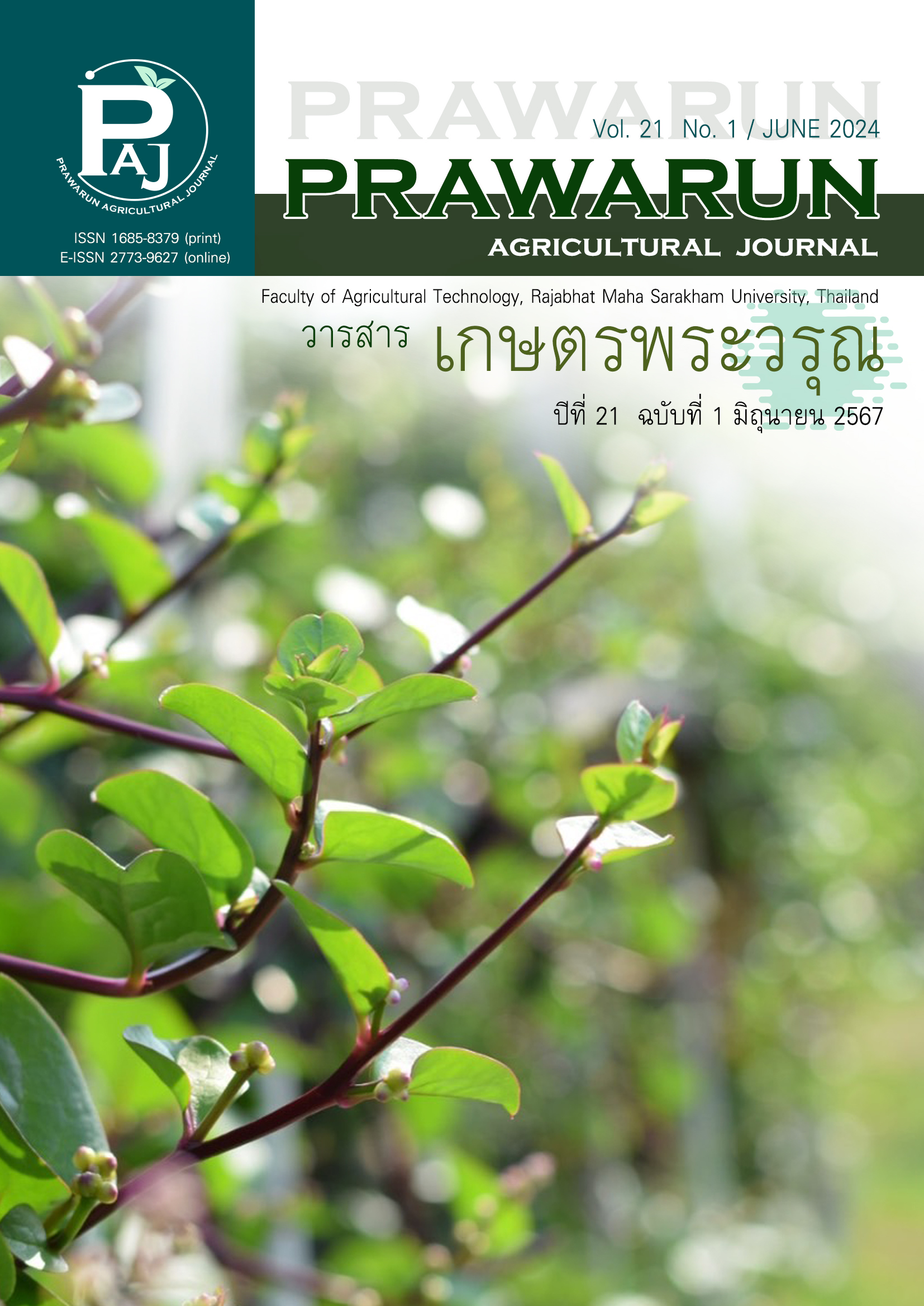บทบาทของวัสดุเหลือใช้ทางการเกษตร: วัสดุทางเลือกสำหรับผลิตแผ่นทำความเย็น แบบระเหย
Main Article Content
บทคัดย่อ
การใช้ระบบทำความเย็นแบบระเหยในโรงเรือนเป็นทางเลือกที่ดีในการจัดการปัญหาการทำการเกษตรในภาวะโลกร้อน อย่างไรก็ตาม ปัญหาที่พบคือราคาแผ่นทำความเย็นที่สูง ทำให้เทคโนโลยีนี้ยังไม่สามารถใช้กับเกษตรกรรายย่อยได้ ดังนั้นบทความปริทัศน์นี้เป็นการรวบรวม วิเคราะห์ และสรุป การวิวัฒนาการ หลักการและวิธีการผลิต เปรียบเทียบประสิทธิภาพการใช้วัสดุเหลือใช้ทางการเกษตรเพื่อใช้เป็นแผ่นทำความเย็น รวมถึงแนวทางการนำไปใช้ โดยจากการสังเคราะห์งานวิจัยที่ใช้วัสดุเหลือใช้ทางการเกษตรที่มีประสิทธิภาพเหมาะสมสำหรับเป็น แผ่นทำความเย็นแบบระเหย พบว่าสามารถลดอุณหภูมิได้ ระหว่าง 3 ถึง 8 องศาเซลเซียส เมื่อเปรียบเทียบกับกระดาษที่ใช้กันอยู่ทั่วไป ซึ่งลดได้ประมาณ 5 องศาเซลเซียส ดังนั้นประสิทธิภาพของวัสดุเหลือใช้ทางการเกษตร จะขึ้นอยู่กับโครงสร้างภายในของวัสดุ ขนาดรูพรุนและปริมาตร ความสามารถในการดูดซับและการระเหยของน้ำ ความสามารถในเพิ่มความชื้นสัมพัทธ์ในอากาศ ความสามารถในการลดตะกอนสะสม ความคงทนของวัสดุ และปริมาณของวัสดุในพื้นที่ เป็นต้น นอกจากนี้วัสดุที่ใช้ต้องมีต้นทุนการผลิตที่ต่ำเพื่อให้เกษตรกรรายย่อยสามารถเข้าถึงและใช้งานได้ ซึ่งเป็นการจัดการเศษเหลือทิ้งทางการเกษตรและก่อให้เกิดการทำการเกษตรต้นทุนต่ำอย่างยั่งยืนในอนาคต
Article Details
เอกสารอ้างอิง
Alibaba. (2022). Coolingpad price. Resources. Accessed February 20, 2022. Retrieved from https://thai.alibaba.com/p-detail/Evaporative-1600089660153.html (in Thai)
Aziz., R. A, Zamrud, N. F., & Rosli, N. (2018). Comparison on cooling efficiency of cooling pad materials for evaporative cooling system. Journal of Modern Manufacturing Systems and Technology, 1(1), 61-68. doi: 10.15282/jmmst.v1i1.199
Babaremu, K. O., Omodara, M. A., Fayomi, O. S. I., Okokpujie, I. P., & Oluwafemi J. O. (2018). Design and optimization of an active evaporative cooling system. International Journal of Mechanical Engineering and Technology, 9(10), 1051-1061.
Department of Alternative Energy Development and Energy Efficiency Ministry of Energy. (2021). Biomass green energy that is friendly to the world. Resources. Accessed August 15, 2023. Retrieved from https://www.thebangkokinsight.com/news/environmental-sustainability/558298 (in Thai)
Dhamneya, A. K., Rajput, S. P. S., & Singh, A. (2017). Experimental performance analysis of alternative cooling pad made by agricultural waste for direct evaporative cooling system. International Journal of Mechanical Engineering and Technology, 8(7), 199-212.
Franco, A., Valera, D. L., & Peña, A. (2014). Energy efficiency in greenhouse evaporative cooling techniques: cooling boxes versus cellulose pads. Energies, 7(3), 1427-1447. doi: 10.3390/en7031427
Franco-Salas, A., Peña-Fernández, A., & Valera-Martínez, D. L. (2019). Refrigeration capacity and effect of ageing on the operation of cellulose evaporative cooling pads, by wind tunnel analysis. International Journal of Environmental Research and Public Health, 16(23), 4690.. doi: org/10.3390/ijerph16234690
Givoni, B. (1993). Semiempirical model of a building with a passive evaporative cool tower. Solar Energy, 50(5), 425-434. doi: 10.1016/0038-092X(93)90064-U
Hassan, Z., Misaran, M. S., Siambun, N. J., & Adzrie, M. (2022). The effect of air velocity on the performance of the direct evaporative cooling system. Proceeding of the IOP conference series: materials science and engineering for sustainable advancement (MEESA 2021) (pp. 1-7). Sabah, Malaysia: IOP Publishing Ltd. doi: 10.1088/1757-899X/1217/1/012016
Hatfield, J. L., & Prueger, J. H. (2015). Temperature extremes: effect on plant growth and development. Weather and Climate Extremes, 10, 4-10. doi: 10.1016/j.wace.2015.08.001
Hemwong, S. (2013). Biochars: carbon sequestration and soil fertility. King Mongkut's Agricultural Journal, 31(1), 104-113. (in Thai)
Kanla, S. (2009). A comparison of physical properties between evaporative cooling pad prototype from coconut fiber with cellulose pad. Air-Conditioning Engineering Association of Thailand. 15, 49-57. (in Thai)
Kapilan N., Isloor, A. M., & Karinka, S. (2023). A comprehensive review on evaporative cooling systems. Results in Engineering, 18, 101059. doi: 10.1016/j.rineng.2023.101059
Khampan, T., Thavarungkul, N., Tiansuwan, J., & Kamthai, S. (2010). Wet strength improvement of pineapple leaf paper for evaporative cooling pad. Proceedings of the world academy of science, engineering and technology (2010-376X) (pp.254-257) Istanbul, Turkey: World Academy of Science, Engineering and Technology.
Kouchakzadeh, A., & Brati, A. (2013). The evaluation of bulk charcoal as greenhouse evaporative cooling pad. Agricultural Engineering International: CIGR Journal, 15(2), 188-193.
Liberty, J. T., Ugwuishiwu, B. O., Pukuma, S. A., & Odo, C. E. (2013). Principles and application of evaporative cooling systems for fruits and vegetables preservation. International Journal of Current Engineering and Technology, 3(3), 1000-1006.
Maneewan, S. (2007). Investigation of physical properties of mulberry paper for evaporative cooling system. Naresuan University Journal, 15(2), 63-72. (in Thai)
Namhormchan, T. (2019). Plant factory. EAU Heritage Journal Science and Technology, 13(2), 46-62. (in Thai)
Namhormchan, T., & Muangchan, N. (2020). Energy conservation in the closed-system greenhouse. EAU Heritage Journal Science and Technology, 14(1), 1-13. (in Thai)
Oliy, G. B. (2020). Comparative effect of brick and charcoal made evaporative cooling storage on shelf life of tomato. International Journal of Scientific and Research Publications, 10(5), 729-734. doi: 10.29322/ijsrp.10.05.2020.p10184
Premjai, N., & Poolkrajang, A. (2011). Study on the efficiency of cooling pad made of natural materials for a broiler house. Proceeding of Academic conference Khon Kaen University (pp.770-774). Khon Kaen, Thailand: Khon Kaen University. (in Thai)
Puttaraksa, P., Nathewet, P., & Mongkon, S. (2017). Potential of evaporative cooling system in a tropical strawberry greenhouse. Proceeding of the 13th conference on energy network of Thailand (pp.56-64)., Chiang Mai, Thailand: Rajamangala University of Technology Thanyaburi. (in Thai)
Rupani, S. V., Jani, S. S., & Acharya, G. D., (2017). Design, modelling and manufacturing aspects of honeycomb sandwich structures: a review. International Journal of Scientific Development and Research, 2(4), 526-532. doi: 10.1712/ijsdr.17013
Salins, S. S., Kota Reddy, S. V. K., Kumar, S., & Stephen, C. (2021). Experimental investigation of humidification parameters using biomass-based charcoal as an alternative packing material. Journal of King Saud University - Engineering Sciences. 35(7), 495-505. doi: 10.1016/ j.jksues.2021.04.005
Tejero-González, A., & Franco-Salas, A. (2021). Optimal operation of evaporative cooling pads: A review. Renewable and Sustainable Energy Reviews, 151, 111632. doi: 10.1016/j.rser. 2021.111632
Yamfang, M, Boonwan, C., Laongwan, C., Assanee, N., Pairintra, R., & Guptasa, M., (2021). The application of combined systems including evaporative cooling and vapor compression air conditioning system for a silkworm rearing house. Journal of Engineering, RMUTT, 19(1): 13-23. (in Thai)
Zellweger, J. (1906). Air filter and cooler. U.S. patent 838602. Accessed February 20, 2022. Retrieved from https://patents.google.com/patent/US838602A/en.


